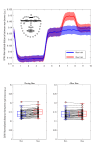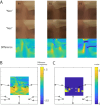The influence of repeated frowning and smiling on corrugator muscle activity and wrinkles between eyebrows
- PMID: 39789039
- PMCID: PMC11717934
- DOI: 10.1038/s41598-024-84121-9
The influence of repeated frowning and smiling on corrugator muscle activity and wrinkles between eyebrows
Abstract
Like the lines themselves, concerns about facial wrinkles, particularly glabellar lines - the prominent furrows between the eyebrows - intensify with age. These lines can inadvertently convey negative emotions due to their association with negative facial expressions. We investigated the effects of repeated frowning on the development of temporary glabellar lines through the activation of the corrugator muscle. In addition, as communication via facial expressions requires precise control over the muscles of the face in such a way as to avoid contradictory signals, we hypothesized that smiling and activation of the zygomatic major may inhibit the corrugator. Our findings reveal that repeated frowning creates temporary wrinkles between the eyebrows, caused by the slight but cumulative activation of the corrugator muscle. Further we found that the act of smiling activates zygomatic major and suppresses the corrugator reducing the appearance of glabellar lines. The results offer a novel perspective on smiling and suggests that smiling not only facilitates positive emotional exchanges but may also help maintain a youthful facial appearance.
Keywords: Corrugator Supercilii; Electromyography; Facial expression; Facial muscle; Zygomaticus major.
© 2025. The Author(s).
Conflict of interest statement
Declarations. Competing interests: All authors are employed as researchers in Shiseido Co., Ltd.
Figures







Similar articles
-
Perception of activity in the Zygomaticus major and Corrugator supercilii muscle regions.Psychophysiology. 1990 Jan;27(1):68-72. doi: 10.1111/j.1469-8986.1990.tb02181.x. Psychophysiology. 1990. PMID: 2339189
-
Resolving the Controversy Surrounding the Function of the Corrugator Supercilii Muscle.Aesthetic Plast Surg. 2025 Mar;49(5):1444-1457. doi: 10.1007/s00266-024-04454-8. Epub 2024 Oct 24. Aesthetic Plast Surg. 2025. PMID: 39448446
-
Muscles that act on glabellar skin: a closer look.Plast Reconstr Surg. 2000 Jan;105(1):350-61. doi: 10.1097/00006534-200001000-00056. Plast Reconstr Surg. 2000. PMID: 10627005
-
Two-plane injection of botulinum exotoxin A in glabellar frown lines.Aesthetic Plast Surg. 2004 Mar-Apr;28(2):114-5. doi: 10.1007/s00266-004-2105-y. Epub 2004 Jun 1. Aesthetic Plast Surg. 2004. PMID: 15170246 Review.
-
Anatomical Proposal for Botulinum Neurotoxin Injection for Glabellar Frown Lines.Toxins (Basel). 2022 Apr 10;14(4):268. doi: 10.3390/toxins14040268. Toxins (Basel). 2022. PMID: 35448877 Free PMC article. Review.
References
-
- Qaqish, C. Botulinum Toxin Use in the Upper Face. Atlas Oral Maxillofac. Surg. Clin. N. Am.24, 95–103 (2016). - PubMed
-
- Dastoor, S. F., Misch, C. E. & Wang, H. L. Botulinum Toxin (Botox) to Enhance Facial macroesthetics: a Literature Review. J. Oral Implantology. 33, 164–171 (2007). - PubMed
-
- Kim, H. J., Seo, K. K., Lee, H. K. & Kim, J. Clinical Anatomy of the Face for Filler and Botulinum Toxin Injection (Springer Singapore, 2016). 10.1007/978-981-10-0240-3
-
- Rosenberg, E. L. & Ekman, P. What the Face Reveals: Basic and Applied Studies of Spontaneous Expression Using the Facial Action Coding System (FACS) (Oxford University Press, 2020).
-
- Hamas, R. S. Reducing the subconscious frown by endoscopic resection of the corrugator muscles. Aesthetic Plast. Surg.19, 21–25 (1995). - PubMed
Publication types
MeSH terms
LinkOut - more resources
Full Text Sources
Medical

